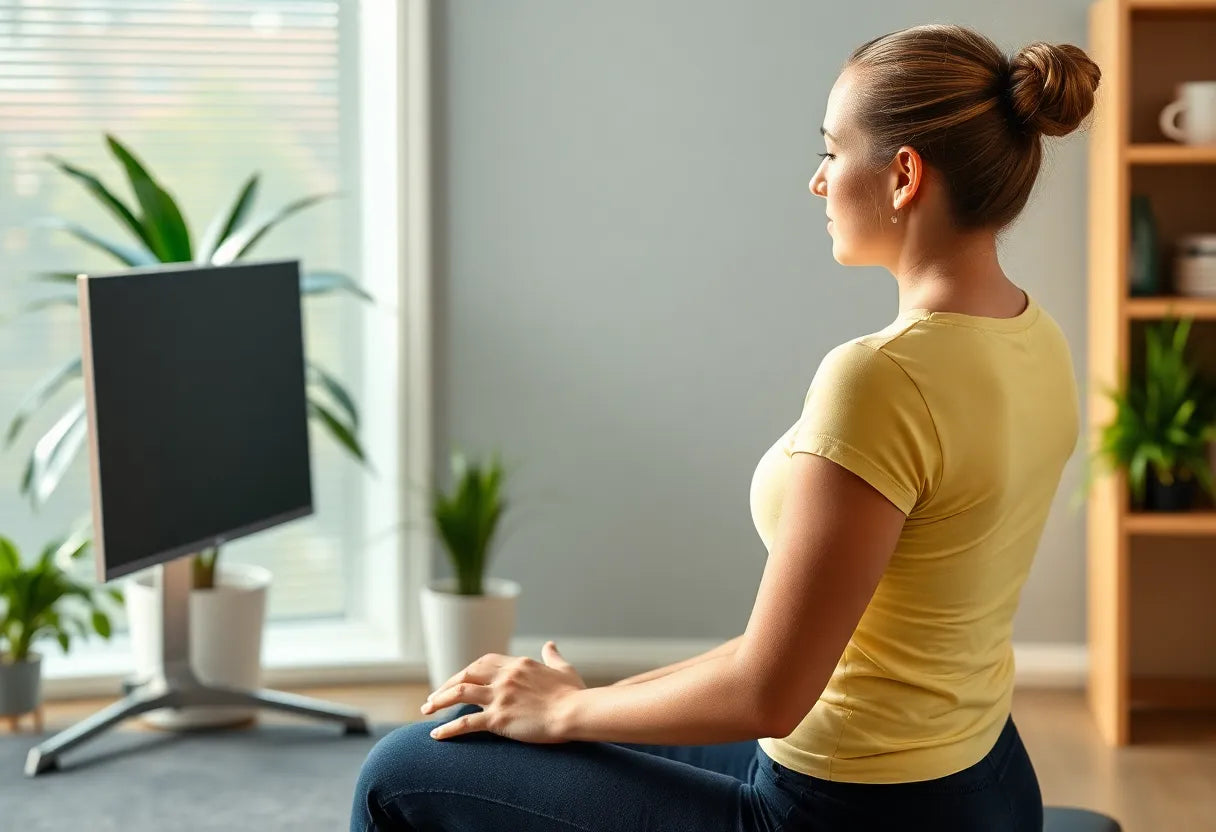Understanding sciatica pain is crucial for those who suffer from this often debilitating condition. Sciatica is characterized by pain that radiates along the sciatic nerve, which branches from the lower back through the hips and buttocks and down each leg. This discomfort is usually caused by a herniated disk, bone spur on the spine, or spinal stenosis compressing part of the nerve. This results in inflammation, pain, and often some numbness in the affected leg.
The impact of sciatica pain on daily life can be profound. It can severely limit mobility and make even simple tasks challenging. The pain can range from a mild ache to a sharp, burning sensation or excruciating discomfort that can make standing or sitting nearly impossible. This can lead to a decrease in physical activity, which can further exacerbate the condition.
However, the importance of exercise in managing sciatica pain cannot be overstated. Targeted exercises can play a vital role in alleviating symptoms by reducing pressure on the sciatic nerve, improving flexibility, and strengthening the muscles that support the spine. This not only helps in managing pain but also in preventing future flare-ups.

Lumbar support belt
Adjustable lumbar belt for lower back pain and sciatica relief at home or on the go.
Introducing exercises into your routine can be a game-changer for those suffering from sciatica. By focusing on stretches and strengthening exercises, individuals can find relief and improve their quality of life. These exercises are designed to target the specific areas that contribute to sciatica pain, providing both immediate relief and long-term benefits.
Engaging in a regular exercise routine tailored for sciatica can help you regain control over your life. It's about more than just pain relief; it’s about enhancing your overall well-being and mobility. So, if you're ready to explore exercises that can provide relief and improve your quality of life, continue reading to discover effective techniques that can make a significant difference.
consultation with professionals
Before embarking on a new exercise regimen, especially when dealing with sciatica pain, consulting healthcare professionals is paramount. Physical therapists, chiropractors, or physicians specializing in musculoskeletal health can provide personalized advice tailored to your specific condition. This step is crucial for those experiencing severe pain or with underlying health conditions, ensuring exercises are safe and effective. Professional guidance can help avoid exacerbating the condition and ensure exercises are performed with correct form and alignment, maximizing their benefits.
exercises for sciatica pain
Incorporating specific exercises into your routine can significantly alleviate sciatica pain. These exercises are designed to target areas contributing to sciatic nerve pressure, enhancing flexibility, and strengthening the muscles that support your spine. Below are some effective exercises to consider:
knee-to-chest stretch
This exercise targets the lower back and glutes, helping to relieve tension and pressure on the sciatic nerve.
- Lie on your back with your knees bent and feet flat on the floor.
- Bring one knee towards your chest, holding it with both hands.
- Hold the stretch for 20-30 seconds, then switch legs.
- Repeat 2-3 times on each side.
standing hamstring stretch
Reducing tension in the hamstrings can help decrease pressure on the sciatic nerve, providing relief from pain.
- Stand upright with one foot slightly in front of the other.
- Bend at the hips, keeping your back straight, and reach towards the toes of the front foot.
- Hold for 20-30 seconds, then switch legs.
- Repeat 2-3 times on each side.
glute stretch
Stretching the glutes can alleviate pressure on the sciatic nerve, offering significant relief.
- Sit on the floor with your legs extended.
- Bend one leg and place the ankle on the opposite knee.
- Gently press down on the knee of the bent leg to deepen the stretch.
- Hold for 20-30 seconds, then switch legs.
- Repeat 2-3 times on each side.
pelvic tilt
This exercise strengthens the lower back and abdominal muscles, promoting better posture and reducing sciatic pain.
- Lie on your back with knees bent and feet flat on the floor.
- Tighten your abdominal muscles and flatten your back against the floor.
- Hold for 5 seconds, then relax.
- Repeat 10-15 times.
bird dog pose
Strengthening core muscles and improving balance, this pose supports the spine and alleviates sciatica symptoms.
- Start on all fours, with hands under shoulders and knees under hips.
- Extend one arm forward and the opposite leg backward, keeping your back straight.
- Hold for a few seconds, then return to the starting position.
- Repeat with the opposite arm and leg.
- Perform 10-15 repetitions on each side.
By integrating these exercises into your daily routine, you can target the root causes of sciatica pain, fostering both immediate relief and long-term improvement. Remember, consistency is key, and while progress may take time, the benefits of reduced pain and increased mobility are well worth the effort.
low-impact activities for long-term relief
In addition to the targeted exercises discussed earlier, incorporating low-impact activities into your routine can significantly enhance sciatica relief over time. Activities such as walking, swimming, and cycling are excellent choices because they promote cardiovascular health without placing excessive strain on the sciatic nerve. These exercises help maintain overall fitness, improve circulation, and strengthen muscles, all of which contribute to reducing sciatica symptoms.
Walking is a simple yet effective way to keep the body active and mobile. It helps to stretch and strengthen the muscles of the lower back and legs, which can alleviate pressure on the sciatic nerve. Swimming is another excellent option, as the buoyancy of the water reduces the impact on joints and allows for a full range of motion, promoting flexibility and relieving tension. Cycling, particularly on a stationary bike, offers a low-impact cardiovascular workout that strengthens the lower body without causing undue stress.
consistency and patience in practice
The journey to alleviating sciatica pain through exercise requires consistency and patience. Regular practice of the recommended exercises and activities is crucial for achieving the best results. While immediate relief may not always be apparent, the cumulative effect of consistent exercise can lead to significant improvements in pain levels and mobility.
It's important to listen to your body and progress at a pace that feels comfortable. Over time, as your flexibility and strength improve, you may notice a decrease in the frequency and intensity of sciatica flare-ups. Remember, the goal is not only to manage pain but also to enhance your overall quality of life. By committing to a regular exercise routine and incorporating low-impact activities, you can take proactive steps towards long-term relief.
frequently asked questions
can exercises make sciatica worse?
While exercises are generally beneficial for sciatica, improper form or overexertion can exacerbate symptoms. It is crucial to consult a healthcare provider before starting any new exercise regimen to ensure that the exercises are suitable for your specific condition.
how often should I perform these exercises?
Aim to perform these exercises at least 3-4 times a week. However, it’s essential to listen to your body and adjust the frequency based on your comfort and progress. Consistency is key to achieving the best results.
are there any exercises to avoid with sciatica?
Yes, it is advisable to avoid high-impact activities and exercises that involve twisting or heavy lifting, as they can aggravate the sciatic nerve. Focus on low-impact exercises and those specifically designed to alleviate sciatica symptoms.
when should I see a doctor about sciatica pain?
If your pain persists despite regular exercise, or if you experience severe symptoms such as numbness, weakness, or loss of bladder or bowel control, it is important to consult a healthcare professional promptly for further evaluation and treatment.

Women's Posture Shirt™ - Black
Patented Posture Shirt™ helps relieve pain and improve posture for daily comfort and mobility.
Källor
- Johnson, L. (2023). "Sciatica and Exercise: A Comprehensive Review." Journal of Pain Management.
- Harvard Health Publishing. (2023). "Sciatica: Gentle Stretches to Help Relieve Pain and Improve Mobility."
- Smith, A. (2023). "Effects of Targeted Exercises on Sciatica." International Journal of Physiotherapy.
- Hospital for Special Surgery. (2023). "Move Better: Sciatica Stretches."
- NHS Recommendations. (2023). "Sciatica Exercises: What Does the NHS Recommend?"
- Mayo Clinic Staff. (2023). "Sciatica: Diagnosis and Treatment."
- Mount Nittany Health. (2023). "Sciatica Self-Care: How to Ease Leg and Back Pain at Home."
- Medical News Today. (2023). "Sciatica Exercises to Avoid."


















